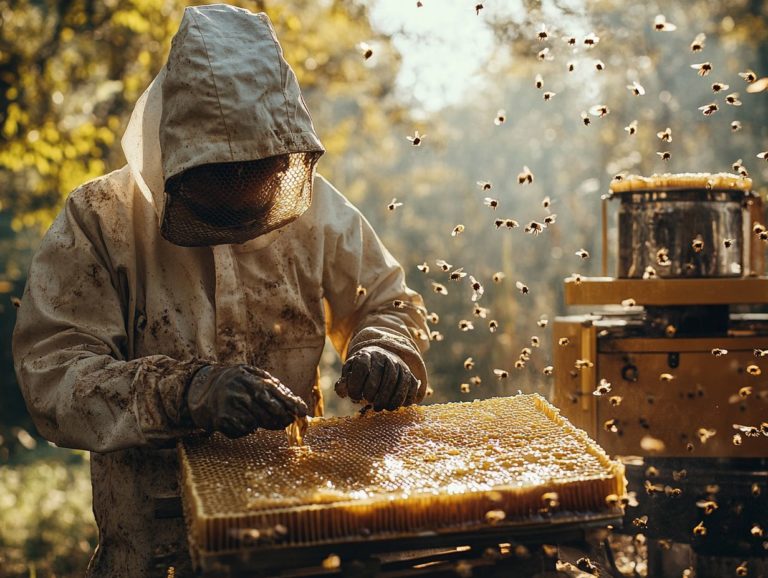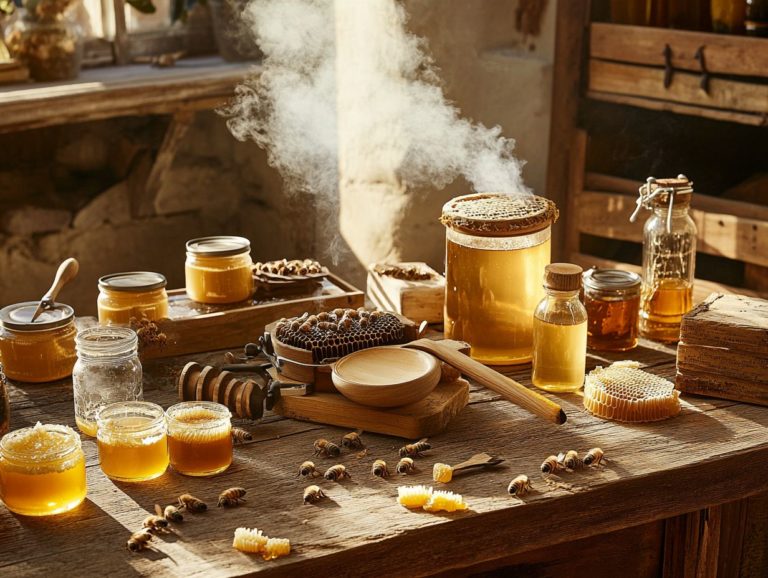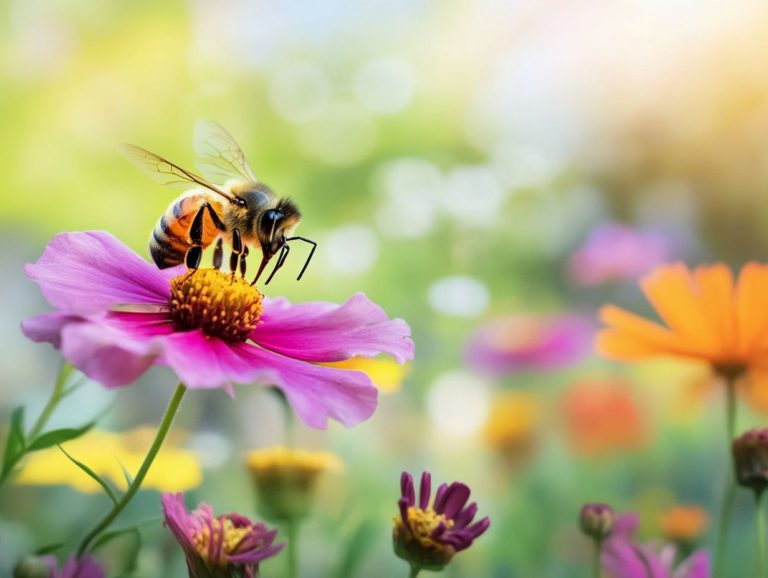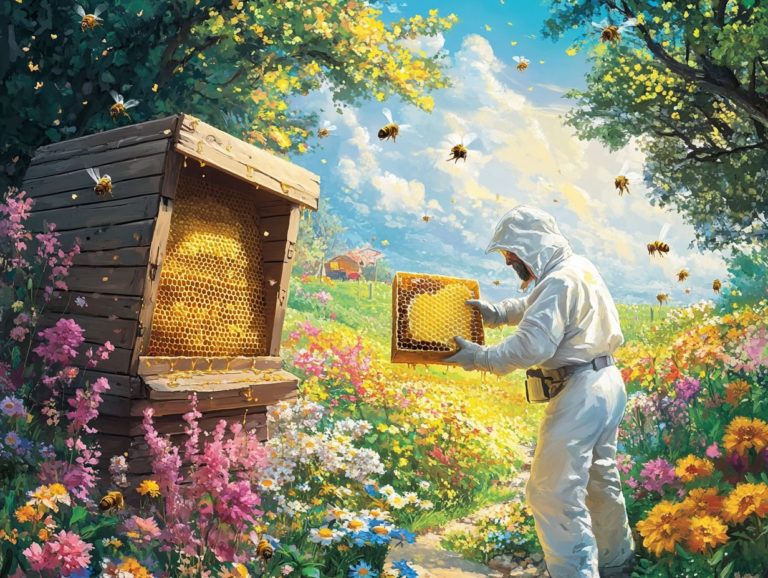The Journey of Honey from Flower to Jar
Honey is a delightful and cherished natural treasure made by honey bees. It has enchanted people for centuries with its rich flavors and numerous health benefits.
But what exactly is honey, and how does it transition from flower to jar? This article explores the fascinating world of honey production, highlighting the crucial role honey bees play in pollination, the intricate process of nectar transformation, the various enzymes involved, and the diverse varieties of honey that await your discovery.
Join us on this exciting journey as we unveil the story of this golden delight, from its meticulous collection to its careful storage.
Contents
Key Takeaways:
- Honey is a natural sweet substance made by honey bees from flower nectar. It comes in different types and flavors depending on the flowers the nectar was collected from.
- Honey bees play a crucial role in the production of honey through pollination. They collect nectar from flowers, transform it into honey, and store it in comb cells.
- The process of honey production involves nectar collection, transformation, comb building, ripening, capping, harvesting honey, and extraction using a honey extractor. Proper storage of honey can extend its shelf life for years.
The Basics of Honey and Beekeeping
Honey, that delightful elixir crafted by honey bees from the nectar of flowers, has enchanted humans and shaped cultures for centuries. The beeswax produced alongside honey also plays a significant role in various applications, from candles to cosmetics. This golden treasure, often gracing your kitchen shelves, nourishes bees and supports the essential process of pollination.
Beekeepers, the guardians of hives, play an essential role in this process, carefully managing bee populations to ensure both the health of the bees and the quality of the honey produced by their industrious foragers. They also manage challenges such as Varroa mites and American Foulbrood to maintain healthy colonies. The captivating world of honey unfolds with its creation, diverse varieties, and the essential connection between bees, flowers, and our environment.
What Is Honey?
Honey is a natural sweetener crafted by honey bees from the nectar they gather from flowers, undergoing a fascinating transformation through chemical processes within the hive. This process involves moisture content reduction and various enzymes to create the final product.
This golden elixir features a distinctive chemical composition, primarily consisting of sugars like fructose and glucose, which contribute to its delightful sweetness and rich viscosity. The bees enhance the honey-making process with enzymes they secrete, breaking down nectar components and stabilizing the honey, ensuring it enjoys an impressive shelf life.
You ll find that the taste, color, and texture of honey can vary dramatically, depending on the floral sources they visit. For example, clover honey is typically lighter and milder, while buckwheat honey presents a robust and dark profile.
Honeycomb plays a vital role in storing this exquisite substance, providing a natural waxy structure that helps preserve its flavor and nutritional value. Plus, it adds a charming touch to your culinary creations.
How Is Honey Made?
The journey of honey production unfolds as you witness honey bees meticulously gather nectar from blossoming flowers, transforming it into honey through an intricate process that involves enzymes, moisture evaporation, and storage in hexagonal cells within the hive.
As these forager bees flit from flower to flower, they collect nectar and store it in their specialized honey stomachs. Upon returning to the hive, they hand off the nectar to house bees, who are essential to the transformation process.
These house bees diligently chew the nectar, blending it with enzymes that kickstart the breakdown of sugars. They then deposit the nectar into hexagonal wax cells, where the magic of evaporation begins.
To achieve the ideal moisture content and create that perfect honey consistency, the bees fan their wings, circulating air throughout the hive. The use of a honey filter during extraction also ensures purity in the final product. This remarkable display of teamwork, coupled with their ability to regulate temperature, ensures the honey is preserved to perfection.
Meanwhile, beekeepers keep a watchful eye on these conditions, safeguarding the quality and safety throughout the entire production process, all to ensure that the final product is nothing short of nature s finest creation.
What Are the Different Types of Honey?
Honey is a delightful treasure that comes in various types, each distinguished by its origin, flavor profile, and processing methods. You can explore raw honey, filtered honey, and unique specialty varieties like Manuka honey, which is often sourced from the Manuka tree in Australia and New Zealand.
Each type of honey presents distinct characteristics that cater to your unique palate and culinary needs. For instance, clover honey offers a light and mild sweetness, making it perfect for sweetening your favorite beverages. In contrast, the robust flavor of buckwheat honey makes it an excellent choice for baking or enhancing marinades.
But honey isn’t just about taste; it also brings a wealth of health benefits to the table. Raw honey is brimming with antioxidants and enzymes that contribute to your overall wellness. Meanwhile, Manuka honey, sourced from the nectar of the Manuka tree in New Zealand, is renowned for its potent antibacterial properties. It s often a go-to for natural remedies, whether for wounds or digestive issues, transforming it from merely a sweetener into a powerful ally for your health.
The Honeybee and Pollination
Honeybees are crucial players in the intricate dance of pollination, a process that is fundamental to the reproduction of flowering plants. This, in turn, profoundly influences biodiversity, food security, and the overall health of ecosystems.
As a result, beekeepers emerge as essential guardians in the effort to sustain these essential insects.
What Is the Role of Honeybees in Honey Production?
Honeybees, especially the forager bees, are the true architects of honey production. They embark on their diligent quests, collecting nectar from blossoms and returning it to the hive for the magical transformation into honey.
These dedicated foragers showcase astonishing navigational skills, journeying up to five miles in search of the finest nectar sources. Meanwhile, their counterparts, the house bees, play an equally vital role by processing this nectar. These house bees are responsible for converting the nectar into honey through a fascinating series of enzyme reactions and evaporation. This intricate teamwork is crucial; the health and productivity of the hive hinge on the seamless collaboration between these two roles.
Maintaining a thriving population of both forager and house bees is essential, not just for honey production but for ensuring the overall resilience of the hive ecosystem. This balance directly influences pollination and biodiversity in the environment, underscoring the importance of these remarkable creatures in our world.
How Do Honeybees Collect Nectar?
Honeybees expertly collect nectar using their long proboscis. They deftly extract this sugary treasure from flowers and store it in their honey stomachs for the journey back to the hive.
The collected nectar is then converted into honey and stored in honey cells within the beehive. As they forage, these tireless insects are particularly attracted to blossoms abundant in nectar, such as clover, lavender, and sunflowers.
Their remarkable communication skills shine through as they execute special dances called the ‘waggle dance.’ This fascinating behavior not only informs fellow bees about the distance and direction to these valuable floral resources but also enhances their efficiency in nectar collection.
It also plays a vital role in pollination. This process helps plants reproduce by transferring pollen from one flower to another.
As a result, the mutually beneficial relationship between honeybees and flowering plants significantly boosts honey production while ensuring the health and vitality of ecosystems.
What Is Pollination and Why Is It Important?
Pollination is the remarkable process where pollen moves from the male part of a flower to the female, paving the way for fertilization, which is when the sperm from the pollen combines with the ovule to create seeds. Among the most effective pollinators are honey bees, whose contributions are vital to the health of ecosystems and food production.
These industrious insects do more than just help flowering plants reproduce; they underpin entire food webs. Many species, including humans, rely on the fruits, vegetables, and nuts that depend on honeybees for pollination.
In fact, honeybees are responsible for pollinating over a third of the crops consumed worldwide, underscoring their crucial role in agricultural economies.
However, their populations face significant threats from various factors such as pesticide exposure, habitat loss, and climate change. These challenges pose urgent risks to our pollination services.
The decline of honeybees does not just jeopardize food security; it also threatens biodiversity, as countless plants depend on them for reproduction. This highlights the intricate interconnectedness of life within our ecosystems, reminding us of the importance of protecting these vital pollinators.
Understanding pollination helps us appreciate the remarkable process of honey production.
The Process of Honey Production
Honey production is an extraordinary journey, beginning with the diligent work of bees. The journey starts with the collection of nectar, a delicate task performed by diligent bees.
This nectar undergoes a fascinating transformation within the hive, where bees work together harmoniously to create something truly special. Threats like Varroa mites and American Foulbrood put the process at risk, which beekeepers must diligently manage.
Finally, the process culminates in the careful storage of honey in beautifully crafted beeswax honeycomb cells, showcasing the intricate artistry of nature.
1. Nectar Collection
Nectar collection marks the initial phase of honey production, where forager bees embark on their quest to gather sweet nectar from blooming flowers, playing an essential role in the entire process.
These industrious workers rely on their acute sense of smell and remarkable navigation skills to pinpoint the richest nectar sources. They often travel impressive distances from their hives.
Various flower types ranging from clover to wildflowers to Manuka honey sources found in Australia offer diverse nectar compositions and volumes, which can dramatically influence the flavor and quality of the honey produced.
As bees busily collect nectar, they also fulfill a vital ecological role by pollinating flowers, ensuring that plant life flourishes. The quality of the nectar they source directly affects the characteristics of the honey, including its color and taste, underscoring the intricate relationship between bees, plants, and the art of honey-making.
2. Nectar Transformation into Honey
Once you collect nectar, honeybees embark on a remarkable journey to transform it into honey. This intricate process involves introducing enzymes and evaporating moisture within the hive, which is critical for crafting that golden sweetness you adore.
During this transformation, specific enzymes, such as invertase (an enzyme that helps break down sugars), play a starring role. They break down sucrose into simpler sugars: fructose and glucose. This process enhances the sweetness and contributes to the honey’s stability.
The initial moisture content of the nectar is crucial, as it can contain more than 80% water. However, bees work tirelessly to reduce this level below 18%. They create a gentle breeze by fanning their wings, promoting airflow, and gradually dehydrating the nectar.
This reduction in moisture not only thickens the honey but also prevents fermentation. This ensures that your honey retains its quality and can be stored for extended periods without spoiling. Thus, this fascinating biochemical process is essential for both the delightful flavor and the preservation of this remarkable natural food.
3. Comb Building and Honey Storage
After transforming nectar into honey, honeybees skillfully construct hexagonal cells from beeswax. This creates a remarkably structured and efficient storage system within the hive. This impressive honeycomb design maximizes space while ensuring that the honey remains sealed and protected from external threats.
Each cell s unique hexagonal shape allows for significant honey storage while maintaining stability and easy access. The beeswax, produced by specialized glands on the worker bees, serves as both the building material and a natural barrier against contaminants and moisture.
Bees in regions like Australia have been known to produce unique types of honey, such as Manuka honey, which has gained international acclaim. By meticulously capping each filled cell with a delicate layer of beeswax, the bees effectively safeguard their precious honey from spoilage, ensuring a reliable food supply for the colony during times of scarcity.
4. Ripening and Capping of Honey
Ripening and capping are the final steps in honey production. Honeybees diligently monitor moisture content and seal honey-filled cells with wax caps, ensuring that the honey remains preserved and safe for your enjoyment.
This process profoundly influences the flavors and textures of the honey you savor. During ripening, the enzymes produced by the bees transform the nectar’s sugars, enhancing both sweetness and aroma.
The bees are experts at assessing moisture levels and instinctively know that excessive water content can lead to fermentation. When the moisture content reaches around 18%, they promptly wax over the cells, creating a protective barrier that locks in flavors and prevents spoilage.
This careful management not only extends the honey’s shelf life but also enriches its complexity, resulting in a unique taste experience that varies with each floral source.
Harvesting and Extraction of Honey
Harvesting honey is essential for you as a beekeeper. It involves the meticulous removal of honeycomb frames from the hive, followed by extraction processes that allow you to produce both raw and filtered honey, catering to the diverse preferences of your consumers.
1. Removing Honeycomb Frames
The first step in harvesting honey involves carefully removing honeycomb frames from the hive. This ensures you disturb the bees as little as possible while preserving the integrity of the hive.
This process demands a gentle touch, as sudden movements can stress out the colony. Utilize specialized tools, like a hive tool, to pry open the frames while wearing protective gear to shield yourself from stings.
As you detach the frames, it s vital to monitor the overall health of the bees. Ensure that enough honey remains for their sustenance and survival.
A keen understanding of bee behavior is essential. Conducting hive inspections during the cooler parts of the day, when the bees are less active, can significantly reduce their agitation.
By adhering to sustainable practices and following local regulations, you can promote both the health of the bees and the longevity of the hive, even in the face of challenges like Varroa mites (a parasitic mite that affects bees) and American Foulbrood (a bacterial disease that can devastate bee colonies).
Remember, the timing of your harvesting process is crucial to ensure the best quality honey. By acting promptly, you can help secure a bountiful harvest!
2. Uncapping the Honeycomb
Uncapping the honeycomb involves removing the wax seals that bees place to protect their precious honey. This prepares you to extract that liquid gold using a honey extractor.
This step ensures the honey-filled frames are ready for extraction and that the pure flavor and quality of the honey remain unspoiled. You’ll want to have various tools at your disposal, such as uncapping knives, uncapping forks, and steam uncappers. These tools are designed to slice through the wax capping without compromising the delicate comb structure.
The significance of this process cannot be overstated. If you don t uncap properly, you might face issues like wax contamination or insufficient honey flow during extraction. These problems can alter the final product s taste, texture, and purity.
By efficiently removing all caps, you ensure a high yield of honey, maximizing the rewards of the bees’ diligent labor.
3. Extracting Honey from the Comb
Extracting honey from the comb is crucial and requires the use of a honey extractor. This device spins the frames to separate the honey from the wax, giving you both raw and filtered honey options to savor.
This procedure uses force to effectively remove the honey while maintaining its natural qualities. Raw honey, in its unprocessed state, is rich in enzymes and nutrients. It’s a prized choice for health-conscious individuals and gourmet food lovers alike due to its remarkable health benefits and distinctive flavor profile.
Filtered honey undergoes extra processing, resulting in a clearer appearance and an extended shelf life. This appeals to mass-market brands. Each type of honey caters to different consumer preferences, showcasing the diverse tastes of those who appreciate either the rustic allure of raw honey or the convenience of filtered varieties.
4. Filtering and Bottling the Honey
After extraction, honey undergoes a meticulous filtering process that removes impurities and beeswax particles. This sets filtered honey apart from raw honey in both texture and clarity.
This essential filtering step is vital for quality control. It ensures the final product meets safety standards and aligns with your expectations as a discerning consumer. By eliminating unwanted debris, filtration yields a smoother consistency and an appealing presentation in bottled honey.
You ll love the way filtered honey looks in transparent jars that highlight its polished appearance. In contrast, raw honey maintains its naturally cloudy texture, often containing small particles and pollen. This makes it a coveted choice for those who appreciate the health benefits of unprocessed honey.
Understanding these distinctions allows you to make informed choices when selecting honey for your kitchen, ensuring you get exactly what you desire.
Storage and Shelf Life of Honey
The storage and shelf life of honey are essential aspects to consider. Honey is celebrated for its remarkable longevity, whether in its raw or filtered form. To preserve its quality and flavor, it’s crucial to store it properly.
How Should Honey Be Stored?
Store your honey in a cool, dry place, away from direct sunlight, and in an airtight container. This helps preserve its delightful flavor, aroma, and nutritional properties, whether you re using raw or filtered honey.
Maintaining proper storage techniques is vital for ensuring that your honey retains its exquisite qualities over time. Honey is hygroscopic, which means it can absorb moisture from the air. This absorption can lead to fermentation if not stored correctly. Improper storage can also attract Varroa mites, which are harmful to both bees and honey production.
It’s also important to monitor the temperature. Maintaining a stable, moderate temperature helps prevent crystallization and prolongs shelf life. Remember, light exposure can degrade the delicate compounds within honey, diminishing its nutritional benefits.
For optimal preservation, choose dark glass containers and store them in pantry cabinets or shielded areas where temperature fluctuations and light exposure are minimized.
What Is the Shelf Life of Honey?
The shelf life of honey is virtually endless thanks to its natural composition.
However, you may notice that the quality can differ between raw honey and filtered honey, such as Manuka honey from Australia. These differences can influence their texture and flavor over time.
Factors such as moisture content and storage conditions significantly impact how well honey retains its desirable characteristics. When you keep honey in a cool, dark place, it s far more likely to maintain its nutrients and flavor for an extended period.
On the flip side, higher moisture levels can lead to fermentation, which compromises both taste and safety.
To gauge honey quality, take a look at its appearance genuine honey typically boasts a vibrant color and a thick consistency. A taste test can reveal delightful floral notes, providing a sensory confirmation of its purity and guiding your choices in both culinary and health-related applications.
Frequently Asked Questions
What Is the Journey of Honey from Flower to Jar?
The journey of honey from flower to jar involves how bees collect nectar from flowers, turn it into honey, and store it in honeycombs before it is harvested for human consumption.
Throughout this process, beekeepers must also monitor for American Foulbrood, a serious disease that can harm bee colonies if not handled properly.
How Do Bees Collect Nectar from Flowers?
Bees use their long, tubular tongues called proboscis to suck nectar from the center of flowers.
They also use their legs to scrape pollen from the stamen of flowers, which they carry back to their hives to make honey.
How Do Bees Turn Nectar into Honey?
Once bees have collected nectar from flowers, they store it in a special “honey stomach” where enzymes are added to break down the complex sugars.
The nectar is then regurgitated into honeycomb cells and fanned by the bees to evaporate excess water, creating the thick, sticky substance we know as honey.
What Happens to Honey After It Is Stored in Honeycombs?
After the nectar has been turned into honey and stored in honeycombs, bees seal the cells with beeswax to preserve the honey.
This method helps to prevent spoilage and ensures the colony has food to survive during times when nectar is scarce.
How Is Honey Harvested from Beehives?
Honey can be harvested from beehives using different methods, depending on the type of hive.
For traditional hives, beekeepers use smoke to calm the bees and then remove the honeycomb frames. For modern hives, a special tool called an “extractor” spins the frames, extracting honey while keeping the bees and honeycomb safe.
What Is the Final Step in the Journey of Honey from Flower to Jar?
Finally, we bottle the honey, sealing in its deliciousness for you to enjoy.
After extraction, the honey is filtered to remove any impurities before being bottled for human consumption. Some beekeepers also add labels and other packaging materials to the jars before they are sold.




